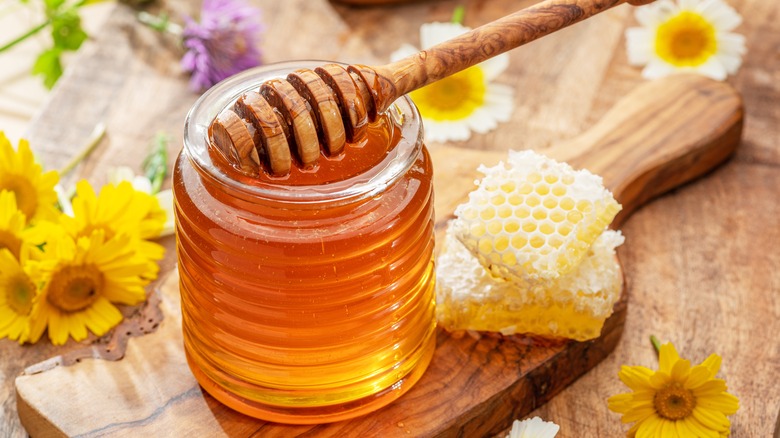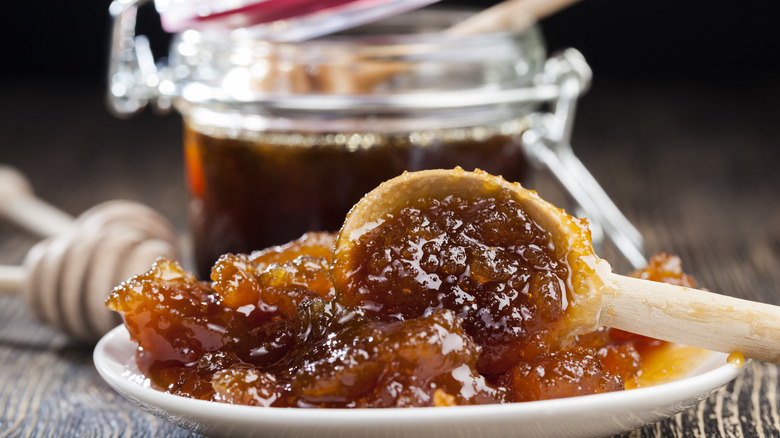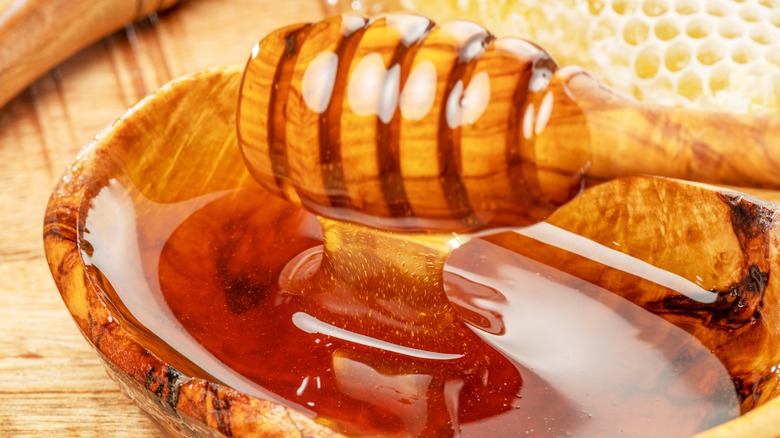The Reason Honey Solidifies And How To De-Crystallize It
The process of making honey is nothing short of impressive. It begins as nectar, a sugary liquid that is produced by flowers. Then, bees play an integral role in its formation by collecting that nectar, bringing it to their hives, and breaking it down into simple sugars. This process occurs both in the bees' stomachs and through the mouth-to-mouth passing of the honey before it is deposited into the honeycomb. Using their wings, the bees reduce the water content within the broken-down sugars even further and the result is delicious honey.
Surprisingly, honey is a food that doesn't expire; this is due to it being low in water, and high in sugar and acid. You may have thought otherwise though, if you have opened your pantry only to find that your honey is completely rock solid and has a crystal-like texture and darker color. That's a process called crystallization, and it happens because of the natural sugars within the honey. While honey is always safe to eat, it can be frustrating to see it has unexpectedly crystallized when you go to use it. Instead of tossing it, take a couple of extra steps to get it back to its liquid state.
Why does honey solidify?
Crystallized honey is a good thing. The process occurs due to the natural sugars within the substance. So if your honey crystallizes, it just means it's real honey that hasn't been overly processed or overheated when bottled. Honey naturally contains glucose and fructose, which both play a role in why honey never expires. Honey also contains less than 20% water, which helps those natural sugars dissolve. But that isn't quite enough water to keep them dissolved for extended periods, so the longer the honey sits, the more likely those sugars will separate and form little sugar crystals.
Just as kinds of honey can have different colors and tastes depending on the flowers from which its nectar was collected, they will also have different time frames when it comes to their crystallization. Other factors that play a role in when honey starts to crystallize include its water content, whether or not bee pollen remains in it in small amounts, and the temperature at which it is stored.
How to de-crystallize honey
Crystallized honey can be funny-looking, but there's no need to buy a new jar. The best method to return your honey to its liquid state is to heat it, which breaks up those crystals and turns the honey back into the smooth, syrup-like texture you know and love.
You can heat the honey in the microwave but do so in small increments — 30 seconds at a time is good — because you don't want to burn it. If you have extra time and want to take a gentler heating approach, it's best to place the honey container in a bowl of warm water; the water will slowly heat it, ensuring it never gets too hot.
Of course, if you don't have the patience to de-solidify the honey, you can still use it in that crystallized form. Its thicker texture makes it easily spreadable on toast — add a little ricotta or burrata on top for a deliciously creamy snack. You can also stir the crystallized honey into a little warmed butter, which will produce a perfect honey butter that's great for waffles and pancakes, too.


